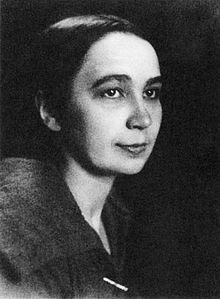 |
| Natalia Goncharova in 1910 |
Background: Natalia was born to a Russian family of noble lineage in a small village south-east of Moscow, and grew up on a large estate. Her father was an architect and graduate of the prestigious Moscow Institute of Art. When she was 10, the family moved to Moscow.
Training: In Moscow, Natalia attended the Fourth Gymnasium for Girls. When she was 17, she followed in her father's footsteps and entered the Moscow Institute of Art. She dropped out after 4 years of a 10-year program, and completed her training with fellow artist Mikhail Larionov.
Private life: In 1900, Natalia and Mikhail formed a romantic and creative relationship that lasted their whole lives; they were the same age. They lived together for decades as an unmarried couple, scandalizing Russian society; they finally married late in life so that whoever survived the other could inherit the work of the deceased.
 |
| Mikhail Larionov |
Natalia and Mikhail moved to Paris in 1914; she was 33. At the outbreak of World War I, they moved to Geneva, Switzerland (a neutral nation).
There is a reference to Mikhail having a mistress in the 1930s, a former student, another Russian émigré named Alexandra Tomilina.
In 1938, at the age of 57, both Natalia and Mikhail became a French citizens and remained in Paris throughout World War II.
Natalia and Mikhail finally married in 1955, when they were both aged 74, in order that the survivor could inherit when one of them died. Natalia died in 1962, and Larionev died two years later. Before he died, Mikhail married his mistress, Alexandra, in order that she would inherit all their paintings, which by this time numbered in the thousands. Alexandra hated her rival and gave away or destroyed many of Natalia's works. Finally, in financial hardship, Alexandra gave the artwork to the Soviet government in turn for financial support.
Career: By 1903, Natalia began exhibiting in major Russian salons. In 1904 she had work in a show that Sergei Diaghilev took to Paris.
In 1910, she joined with several others in forming Moscow's first radical independent exhibiting group.
She participated in other independent art shows as well around this time.
Initially she was preoccupied with icon painting and the primitivism of ethnic Russian folk-art. This Neo-Primitivism style was taken up by artists in both Germany and Russia. Her paintings melded Fauvism's bold use of color with the simplicity and emphatic energy of icons.
She was a member of The Blue Rider group from its founding in 1911. That means she would have known Gabriele Münter and Wassily Kandinsky. Kandinsky was a Russian painter who had gone to Munich for training. There were other Russian members of The Blue Rider group.
Around 1912 Natalia began introducing Cubist techniques, such as multiple viewpoints, into her work, as well as aspects of Futurism. She and her Russian colleages referred to their style as "Cubofuturist."
In 1913 Mikhail developed the theory of Rayonism, which sought to represent the feeling and essence of an object by painting its emitted rays, rather than its literal form, and Natalia did some exciting works in this mode as well.
Natalia and Mikhail moved to Paris in 1914 to design sets for Serge Diaghilev’s Ballets Russes. During the war they joined Diaghilev in Geneva and worked on his shows there. They returned to Paris after the war and continued designing for Diaghilev. From this point, Natalia and Mikhail virtually gave up easel-painting to concentrate on theatrical design.
In the early 1920s Natalia also created fashion designs influenced by Russian Folk Art.
Diaghilev's death in 1929 meant that Natalia and Mikhail had no regular work, although they did get commissions for theatrical design work from other impressarios, and Natalia did some book illustrations.
Today, the majority of Goncharova’s paintings from before World War I are at the State Tretyakov Gallery in Moscow, where we enjoyed viewing them in 2005.
My photo of Natalia's work:
 |
| Les porteuses, 1911 Pompidou / Jan's photo, 2015 |
 |
| Spanish Dancer, c. 1916 Chicago / Jan's photo, 2010 |
Internet examples:
 |
| Self-Portrait, 1907 |
 |
| Gardening, 1908 |
 |
| Picking Apples, 1909 |
Neo-Primitivism
Rayism
 |
| The Green and Yellow Forest, 1912 |
 |
| The Cyclist, 1913 |
 |
| Costume for a squid, c. 1916 |